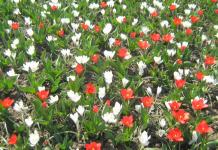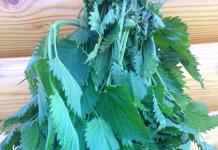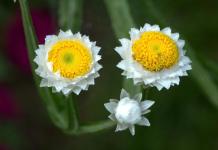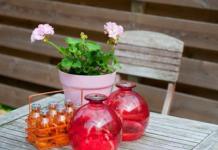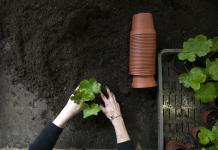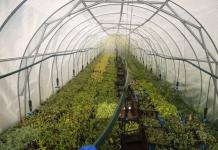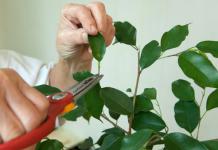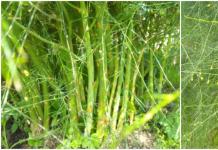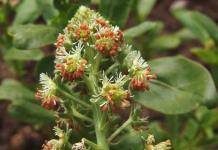To successfully master the agricultural technology of growing lemon and other citrus crops in greenhouses, and even more so in office and residential premises, you need to understand that representatives of citrus fruit crops were formed in a humid and hot climate, therefore, for their successful growth, development and fruiting, they require the same or close ones with the specified conditions.
With the spread of citrus fruits to different subtropical regions, they gradually adapted to the harsh environmental conditions.
Citrus fruit crops are equally demanding for heat, light and moisture. For example, it was found that illumination affects the phases of growth, the rate of ripening of fruits and the intensity of their color.
Citrus fruits are very sensitive to frost, especially lemon. For example, in the Caucasus, when grown in open ground, lemon can withstand frosts within the range of almost minus 5 -6 ° C, orange - minus 7 - 8 ° C. Some varieties of Kinkama mandarin are most hardy in these conditions, sometimes they can withstand up to minus 9 ° C, but at the same time the leaves and young, insufficiently lignified shoots are shed.
For the normal passage of all life processes, citrus crops need such a sum of active temperatures: for mandarin - 4200 ° C, lemon -4200 ° C, orange - 4500 ° C.
For this reason, for different types citrus fruits, it is necessary to create such agricultural technology that would meet the requirements of the culture grown. Particular attention should be paid to providing plants during the period of relative winter dormancy with a large supply nutrients, and during the period of intensive growth by irrigation.
To ensure high annual yields, leaves should not be allowed to fall and weakened plants, as well as damage them to the most important for citrus fruits winter period.
Agricultural technology for growing lemon in the room
We believe that for the amateur beginner who wants to master the agricultural technology of growing citrus fruits indoors, you should start with lemon. This citrus fruit grows better in potting (in many zones), in addition, there are a number of varieties specially created for growing lemon in indoor conditions... Note that in no case should you try to grow fruits on plants grown from seeds, since such plants are young in stages and even with proper care, they can bloom and give the first fruits no earlier than 12-15 and, even , 18 years. In order to successfully and effectively grow lemons, plants of vegetative origin must be used for planting, that is, those grown by rooting cuttings (cut from fruiting plants), layering or grafted.
So, if a lemon or orange seedling is growing on your window in a pot, you first graft it with a bud (ooculate) or live, taken from a fruiting lemon, grow a cultivated seedling from it, and only then arrange for proper care and try to get fruit.
Lemon, like all other citrus fruits, belongs to the type of remontant plants that can bloom and bear fruit all year round. On a plant that has entered fruiting, there can be ripe fruits at the same time, ovary and flowers of various sizes. Lemon blooms especially massively in spring (March-April), as well as in autumn (October-November) Lemon fruits ripen within 8 - 9 months. With proper care of the indoor lemon tree (watering, feeding, lighting, etc.), plants can give up to 50-60 fruits already in the 3-5th year. Although lemon is an evergreen plant, the leaves on it periodically fall off.
Bulk dropping lemon leaves
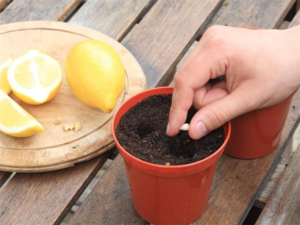
Leaves on indoor plants live for three years. To replace the fallen ones, new, young ones grow. If leaves fall on the plant at the same time, this should alert the owner (which is not the case with the plant). Complete loss of lemon leaves will cause the plant to fail next year.
Here, along the way, it is necessary to warn amateurs against the misfortune that inexperienced plant growers can get into when buying plants in the markets, from random people. Often in the market you can find a Georgian who sells a small lemon tree, even with small fruits. These plants should not be purchased. The fact is that lemon is a low-wintering plant. When growing it in open ground, in the Crimea, in the Caucasus, in Central Asia, seedlings are grown on seedlings of tripolyates (three-leafed lemon) in order to increase the resistance of the lemon tree to low temperatures that are there in winter. Trees grown on a trifoliate rootstock are unsuitable for growing indoors, because leaves are shed with the onset of autumn. Therefore, buying such plants and trying to grow them as an indoor crop is not worth it.
Lemon soil
In order for lemons to grow and bear fruit successfully, you need to take care of the composition of the soil in advance, which you need to fill the flowerpot box or pot. When preparing a soil mixture, take two parts of sod land, one part of deciduous, humus and clean river sand. All these ingredients are mixed well and filled into the vessel when the plants are planted.
A small lemon tree should not be planted in a large bowl, this negatively affects its growth, since a small root system cannot master the whole earth and it can sour. It is better to transfer the tree from a small vessel to a larger one as it grows. Fruiting plants are transplanted once every 2 - 3 years with the replacement of part of the soil mixture.
Top dressing lemon
Indoor lemons are periodically fed with organic and mineral fertilizers during their cultivation. From organic it is better to use fresh mullein, one part of which (in fermented form) is diluted in 7 - 8 parts of water. You can also use poultry manure, which is diluted 1:15. For fertilizing with mineral fertilizers (nitrogen, potassium and trace elements), they use special packages that are sold in flower shops.
Forming and pruning a lemon tree
When growing lemons in greenhouses, it is important to form a beautiful, strong, well-branched crown.
When a lemon sapling (obtained by rooting a cutting) takes root well and forms a plant 25 - 28 cm high from the surface of the earth, it is formed by pruning and pinching.
At a seedling of a given height, pinch the top (remove the two upper leaves). So pinching will stop the growth in height. After a while, several lateral buds will sprout on the trunk, which form one vertical and 3 - 4 lateral shoots (when there are more of them, the extra ones are removed to the ring). These will be the skeletal branches of the crown and a neutral conductor. When these branches reach a length of 25 - 30 cm, it is worth removing the top on them in order to stop growth and over time, on these 3 - 4 lower (skeletal) branches, on which lateral buds awaken to growth, shoots are formed, that is, to lay twigs of the second order. For the formation of branches of the third and higher orders of branching with new shoots, you should do the same. When twigs of the third, fourth orders of branching are formed in the crown of a grown lemon tree, such a plant will be able to bloom and set fruits. With the entry of a tree into fruiting, its vegetative growth slows down, and fruiting increases. During this period, caring for the lemon crown consists in cutting out the extra branches (not necessary) for the formation of the crown into a ring, and removing those that grow in the middle of the crown and thickening it from the crown or pinching it.
Watering
In order for a grown plant to grow and bear fruit normally, it should be looked after. It is especially important to water moderately, preferably with river or rainwater. Water from the water supply network must be defended in an open container for 1-2 days. It should be remembered that excessive moistening of the soil in the vessel where the lemon grows is not desirable. The soil should be moderately moist. When the leaves on the plant begin to resemble a shuttle, this indicates that the air in the room is dry. Such a plant should be sprayed with water at room temperature at least once a day.
Supplementing in winter
As noted above, citrus plants were created in warm and humid climates and in conditions where night is always equal to day. Therefore, plants grown indoors are quite demanding on light. This is especially noticeable in autumn and winter, when the night is even longer than the day. To create conditions for lemon favorable for normal life, plants grown in room conditions must be supplemented (with 75 W electric lamps) with a reflector in October for 5 hours, in November 7, December - 8, January - 7, February - 8, March - 5 Without additional lighting, plants can shed their leaves, which will negatively affect their fruiting These are the main (far from complete) requirements that should be paid special attention to when growing lemons in residential premises or offices.
Features of growing lemon from seed
Lemon is a thermophilic plant that grows in the wild in tropical rainforests. Thanks to the work of breeders, many varieties and varieties of this tree have been bred, and now citrus fruits can be grown not only on plantations in the southern regions, but also in greenhouses and even on the windowsill of a city apartment. There are several ways to grow lemon, the most popular are two:
- sowing seeds (bones),
- rooting of the cutting.
The grafting method is simpler, but sowing seeds is very exciting and will appeal to all lovers. indoor plants... How to grow a lemon from a seed and what is required for this?

Seed selection
Seed material is practically not found on sale, so a grower needs to buy a fruit on the market and take seeds from it. Lemon is chosen ripe and without signs of any disease. It is difficult to determine this by eye, in any case, the crust should be of an even, natural color and not have any damage or defects. The seeds dry out quickly and lose their germination, so it is necessary to plant them in the ground as soon as possible. Ideally, even the remnants of the pulp on the outer shell should not have time to wind up.
Substrate preparation
How to grow a lemon from a seed, what kind of soil is needed? The plant will need nutritious and loose soil. You can purchase a ready-made mixture for growing flower seedlings or prepare it yourself:
- fibrous peat substrate - 2 parts,
- leaf land - 1 part,
- calcined river sand - 1 part.

The prepared substrate is poured into a wide box or small containers (cups). The soil should be well loosened and slightly moistened. The bone is placed horizontally on the ground so as not to confuse its upper and lower parts - on the one hand, the root system will develop, and on the other, a sprout will appear. Then the bone is covered with an even layer of earth (1.5 cm is enough), moistened with a spray bottle and covered with glass or a piece of polyethylene.
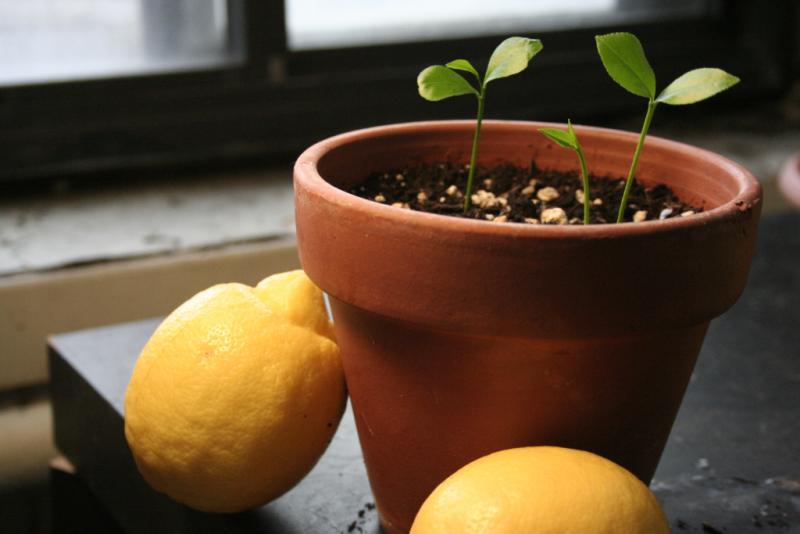
Growing seedlings
To grow a lemon from a seed as soon as possible, you will need to create an optimal microclimate. At this stage, it is necessary to carefully monitor the condition of the soil, it should be moistened, but not damp, excessive drying should not be allowed either. After about 5 weeks, the first shoots will hatch, they should be watered very carefully, and it is better to moisten from a spray bottle.
As soon as the 6th sheet appears, they begin to dive into more spacious containers. If several specimens have been planted, then only the strongest are selected for planting. Given that the roots of the plant are still weak and brittle, the seedlings are removed from the soil very carefully so that the central root does not break. During the pick, it is cut with sharp scissors, this is done so that the root system grows not only in depth, but also to the sides, which will significantly speed up the process of plant survival.

Preparing a substrate for growing a young seedling
How to grow a lemon from a seedling? At this stage, the young plant is ready to be transplanted into a pot, where it will be kept for at least a year. The substrate must be prepared taking into account the needs inherent in adult specimens.
Components of the potting mix:
In the next transplant, when the tree is 3-4 years old, a fibrous-peat substrate is added to the composition, and wood ash, on the contrary, is excluded.
Planting a lemon sapling
Knowing how to grow a lemon from a seed, the grower will no longer have any difficulties with planting a seedling. Drainage is laid at the bottom of the pot (expanded clay, clay shards are suitable) and a little soil mixture is poured from which a hill is made. Sprinkle the roots of the seedling with a small amount wood ash and gently spread on an earthen hill. The remains of the soil are evenly filled in the container, periodically tamping the soil.
The root collar of the plant cannot be sprinkled with earth, this will provoke its decay and the development of fungal diseases.
Features of caring for lemon at home
If the transplantation of the seedling was successful, then soon the plant will have new shoots and leaves. Now the lemon needs to be well cared for, and then there will be a beautiful, evergreen tree on the grower's windowsill.

Lighting
Lemon prefers bright, but slightly diffused sunlight. It is best to keep it on the sill of an east-facing window so that the sun has already disappeared by noon.
Air temperature
The tree grows well at moderately warm air temperatures. How to grow a lemon and create a comfortable environment for it? It will be enough to maintain the indoor temperature at + 18–20 ° C, this is the optimal indicator for active growth and flowering. Further, during the ripening of the fruit, it must be increased by a couple of degrees. In winter, when the plant is resting, + 16-18 ° C is sufficient.
Air humidity and watering
Lemon is a resident of the tropics, so a humid microclimate is necessary for it. This can be achieved by regularly spraying the plant, as well as placing a decorative container near it, filled with river pebbles and water. It is useful to have a shower every 10 days, this procedure will refresh the plant and remove dust particles.
The tree loves moisture, it should not be watered too abundantly, but regularly (2-3 times a week in summer, in winter - much less often). The water should be warm and free of chlorine impurities.

Fertilization
Every week, a lemon tree is fertilized with mineral and organic compounds, alternating between them. You can purchase a liquid fertilizer for citrus plants from Bona Forte. In winter, feeding is carried out no more than once a month and only if the plant bears fruit.
Pruning and blooming lemon
The crown begins to form in early spring, leaving shoots with five leaves. This pruning produces a compact, branchy bush and stimulates early flowering. The buds appear already in the 2nd or 3rd year. During the first flowering, the number of buds is controlled, leaving no more than half, otherwise the plant will weaken. The same is done with the resulting ovaries, leaving no more than 4 pieces.
It is not so easy to achieve flowering and fruiting at home. In addition, seed-grown trees usually bloom no earlier than 5–8 years later. Therefore, a florist should be patient and for the first time grow his pet exclusively as an ornamental deciduous plant.
Video how to grow lemon from seed
The lemon plant belongs to the genus Citrus of the Rutaceae family. The homeland of lemon is India, China and the Pacific tropical islands. It was introduced into the culture in Pakistan and India, and then spread to southern Europe, the Middle East and North Africa. Where does lemon grow nowadays? Today this plant is cultivated in countries with subtropical climates such as Italy, Mexico, India and the USA.
For indoor floriculture, lemon is also of interest at home. grown in many countries of the world... It enjoys such popularity not only because of its decorative effect. Some homemade lemons are as delicious as lemons grown in the southern sun. Let's take a closer look at how to grow a lemon from a seed at home.
Room lemon is perennial evergreen having strong thorny branches. Leaves of this undersized tree oblong-oval, leathery, serrated, green, which contains essential oil... Bud development takes place within five weeks. A blossoming flower lives for 7-9 weeks, and such a bloom has a wonderful fragrance.
Fruits ripen from the moment of formation of the ovary and ending with full maturity for more than 9 months. They are covered with a lumpy or yellow pitted peel with a characteristic odor. White ovoid seeds are covered with a dense shell.
Gallery: lemon at home (25 photos)


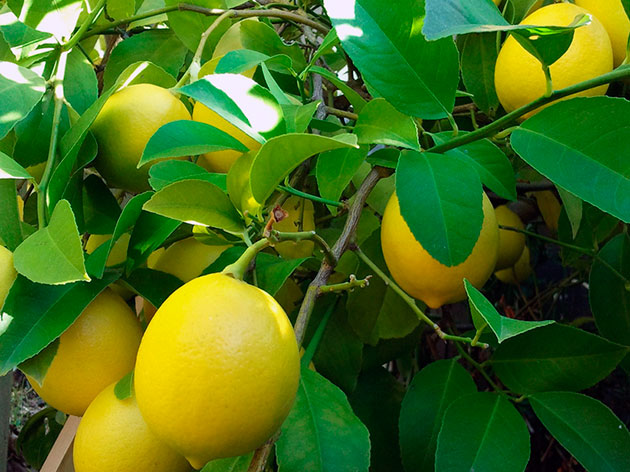


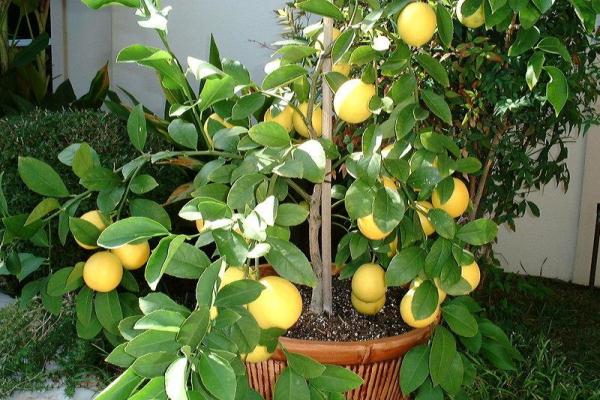
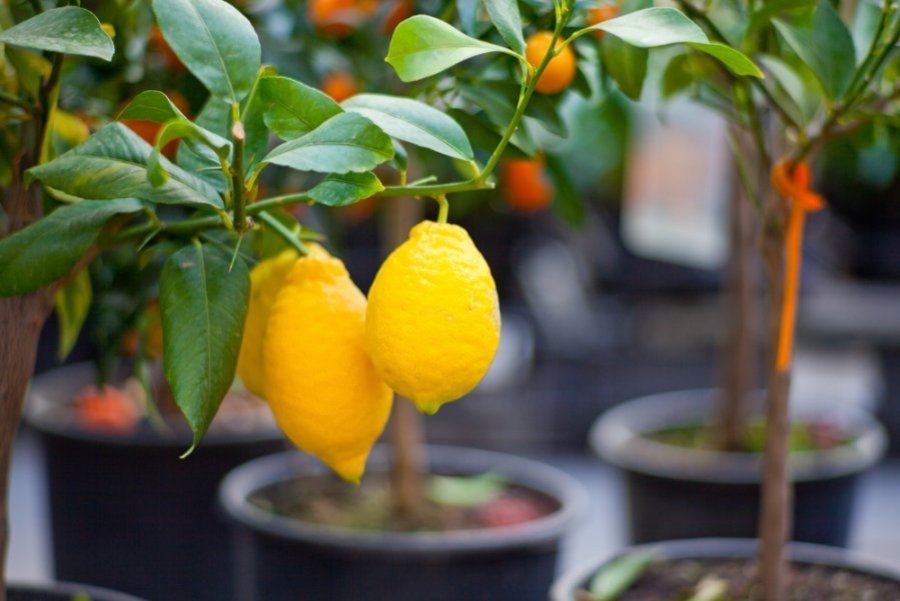









![]()
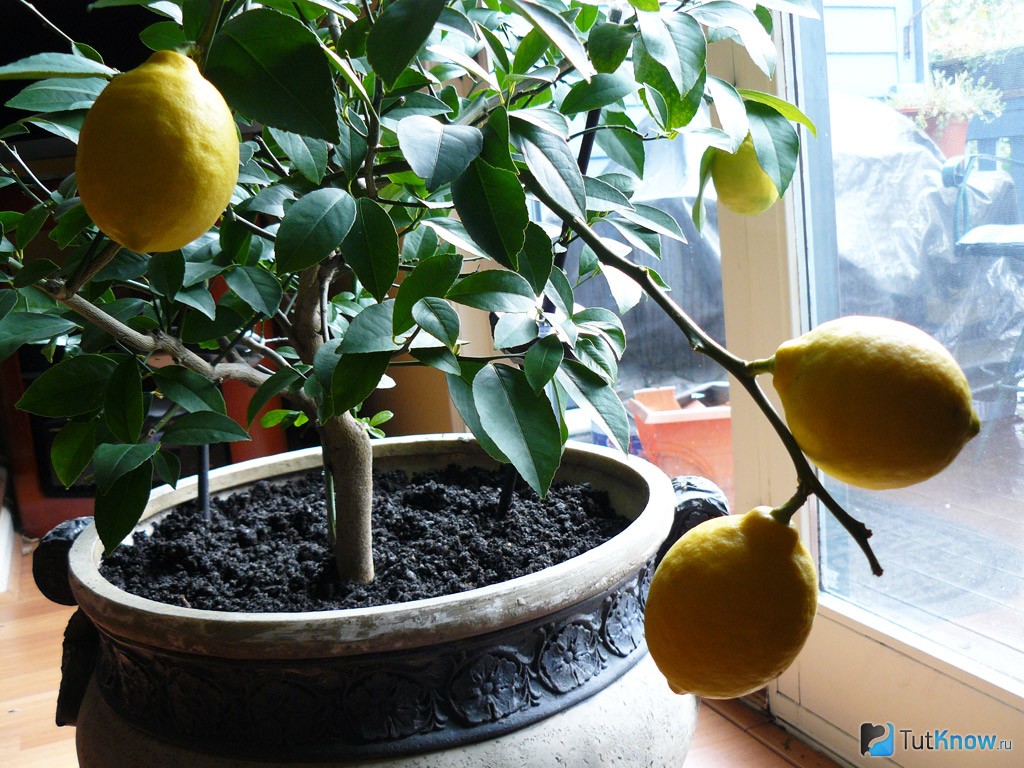




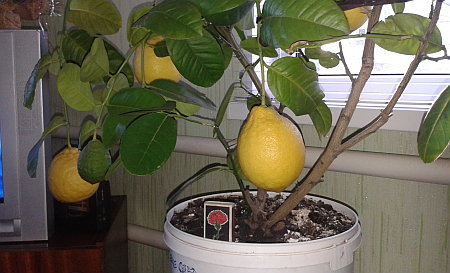

Growing lemon at home
Lemon is usually grown at home from bone... For this, the seeds are taken from fruits that are purchased at the store. The fruits must be ripe, yellow in color, and the seeds in them must be ripe and mature. The substrate for growing lemon from seed at home must be of a certain composition. To do this, mix the soil for flowers from the store and peat in equal parts, as a result of which the composition is light and well-permeable to water.
Drainage, a substrate are placed in a prepared container and lemon grains are placed in it immediately after they are removed from the fruit. Crops should be kept in a bright room at a temperature of 18-22 degrees. If the soil is kept moist, then after two weeks the seeds begin to germinate.
The planted bone needs to be watered water at room temperature... It is recommended to loosen the soil in a pot, but this should be done very carefully. It is necessary to transplant strong seedlings into separate pots when a pair of true leaves appear on the sprouts. To create the necessary microclimate, cover the pots with a glass jar. It is removed for a short time once a day to air the seedlings.
Lemons should be kept in pots until they reach a height of 15–20 cm, after which they should transplant into larger pots... Landing is carried out by transshipment. A thick layer of drainage is placed on the bottom of the container. To do this, use:
- pebbles;
- charcoal;
- broken foam;
- expanded clay.
As a soil, use garden soil fertilized with humus or flower soil from a store. During transplantation, the root collar should not be buried in the ground, as it can rot.
Lemon care at home
How to grow lemon at home? Growing it up home tree- it's not easy. Since lemon is considered a plant of short daylight hours, it easily tolerates a lack of lighting... Due to the long daylight hours, it begins to grow faster, but the onset of fruiting is delayed. In an apartment, this tree is best grown on the eastern and southern windowsills, but after lunch, the windows should be shaded. To make it grow even, it should be turned in different directions every week. In winter, if the plant is not resting, then artificial lighting can be arranged for it for 5-6 hours.
Temperature
 How to take care of lemon at home? In order for it to grow well, it needs comfortable temperature... For the growth of leaves, it is enough to be 17 degrees, and during the period of bud formation, it should be 14-18 degrees. As the temperature rises, the plant begins to shed ovaries and buds. But when the fruit grows, it is recommended to increase the temperature to 22 degrees or more.
How to take care of lemon at home? In order for it to grow well, it needs comfortable temperature... For the growth of leaves, it is enough to be 17 degrees, and during the period of bud formation, it should be 14-18 degrees. As the temperature rises, the plant begins to shed ovaries and buds. But when the fruit grows, it is recommended to increase the temperature to 22 degrees or more.
With the onset of warm days, the lemon can be taken out to the balcony, terrace or garden, but care must be taken to ensure that it does not suffer from a sharp temperature drop. For this, the plant is covered or wrapped at night. In winter, lemon feels comfortable in a room with a temperature of 12-14 degrees, and it should be kept away from heating appliances. In this case, he will remain at rest and gain strength for fruiting.
Watering
The lemon tree needs to be watered every day from May to September, and the rest of the time it is recommended to moisturize it twice a week. The plant needs to be moistened abundantly, but the substrate should dry out before the next watering. It is desirable that the water is filtered or settled. In addition, the water should be at room temperature.
Growing and caring for lemon involves spraying its leaves with warm water. It is especially recommended to do this in winter, when the room is in full force heating devices are working. In this case, moderation must be observed, since otherwise the fungus may attack the plant. If the lemon tree is resting in winter, then it is not necessary to spray the leaves.
Fertilizer
How to care for indoor lemon? It must be fed with complex mineral compounds. Young plants should be fertilized once a month and a half, and adults more often: in spring and summer, fertilizing is applied once every 2-3 weeks. Starting from mid-autumn, fertilizing is gradually reduced, and in winter a tree that grows all year round without rest is fertilized once every 1-1.5 months. If a lemon is resting in winter, then it will do without feeding at all. 2 hours before fertilization, the substrate in the pot must be watered with clean water.
From organic fertilizers indoor lemon prefers:
- diluted infusion of fresh manure;
- infusion of birch or quinoa leaves;
- ash hood.
The frequency of making such a top dressing is the same as for complex mineral fertilizers... If the green mass begins to grow rapidly, and fruiting does not occur, then the nitrogen component must be removed from the dressings, and the phosphorus must also be increased.
Pruning
 Caring for indoor lemon involves regular pruning. Its crown is formed depending on the purpose for which it is grown. If it will be used like ornamental plant, then its crown should be formed compact, but if its fruits are needed, then the formation is carried out in a slightly different way.
Caring for indoor lemon involves regular pruning. Its crown is formed depending on the purpose for which it is grown. If it will be used like ornamental plant, then its crown should be formed compact, but if its fruits are needed, then the formation is carried out in a slightly different way.
The crown is formed by pinching, for this the first zero shoot is pinched when it reaches a height of 20-25 cm, and the next pinching of the shoot is carried out at a height of 15-20 cm from the previous pinching. In the area between the two pinches, you need to leave 4 developed buds, which then form 3-4 main shoots. Shoots of the first order should be pinched after 20-30 cm. The formation of the crown is completed on the shoots of the fourth order.
It is imperative to cut the plant, because its branches grow very long, while the formation of shoots of the third and fourth order, on which the formation of fruits occurs, is delayed. In addition, pruning also performs a sanitary function, since weak shoots are removed, as well as branches growing inside the crown.
Diseases and pests of the lemon tree
This plant can be affected by diseases and pests. Let's consider the most common ones.
The lemon turns yellow. There are several reasons for this:
- dry air in the room;
- lack of nutrients;
- too warm room in winter;
- spider mite damage.
All these reasons, with the exception of the last one, are eliminated quite easily, and with spider mite such drugs as Fitoverm, Kleschevit, Akarin and Aktellik help to fight. It is imperative to follow the rules for caring for a lemon tree: in winter, keep it in a cool place, humidify the air in the room, and apply top dressing in a timely manner.
The lemon tree falls... Leaves can fall off due to the attack on the plant by spider mites, feeding on its cell sap. You should deal with it in the same way as in the previous case. You can also treat the lemon with grated onion infusion. Leaves, as well as buds, can fall off from a lack of moisture in the ground and in the air. Water and spray the lemon tree regularly, especially in extreme heat.
 The plant dries up... Sometimes the tips of the leaves dry out and turn brown. This is caused by dry air or lack of moisture. But if the leaves begin to dry out and curl, then this indicates improper care. Therefore, you should revise the rules for caring for lemon. In addition to diseases, lemon can be affected by various pests. In addition to the spider mite, the following insects can harm this plant:
The plant dries up... Sometimes the tips of the leaves dry out and turn brown. This is caused by dry air or lack of moisture. But if the leaves begin to dry out and curl, then this indicates improper care. Therefore, you should revise the rules for caring for lemon. In addition to diseases, lemon can be affected by various pests. In addition to the spider mite, the following insects can harm this plant:
- shield;
- mealybug;
- whitefly.
To get rid of them, use the following folk remedy: 150 g of chopped garlic is insisted in a liter of water for 5 days, then the infusion is filtered and 6 g of this agent is diluted in a liter of water. The resulting infusion is used to process the plant. This remedy is effective only if there are few pests. If the lemon tree is inhabited by a large number of insects, then it is treated with insecticides.
 Thus, to the question: how to care for homemade lemon, many indoor plant lovers will answer that this is not an easy task. It is not just important that it grows, but it is necessary to ensure that the lemon tree bears fruit. To do this, you need to follow the rules for growing and caring for lemon.
Thus, to the question: how to care for homemade lemon, many indoor plant lovers will answer that this is not an easy task. It is not just important that it grows, but it is necessary to ensure that the lemon tree bears fruit. To do this, you need to follow the rules for growing and caring for lemon.
Attention, only TODAY!
If you have a lemon "settled", caring for it at home will require a lot of work. It belongs to remontant plants, therefore, under certain conditions, it is able to bloom and bear fruit all year round. But not everyone succeeds not only in trying the fruits of their citrus, but also just admiring the flowering. What is the reason? Let's figure it out.
Variety selection

First of all, for planting in the house, you should choose varieties specially bred for these purposes. They do not grow to gigantic dimensions, but at the same time they are characterized by high yields. Pay attention to these varieties of dwarf and semi-dwarf lemons:
- Meyer
- Pavlovsky
- Novogruzinsky
- Maikop
- Eureka
- Genoa
Among the most common varieties in our latitudes, Meyer's lemon, caring for it is the least troublesome in comparison with other species. This variety is sometimes called the Chinese dwarf, and its fruits are not as sour as other varieties. Dwarf lemons do not have a rich harvest, but they will add comfort to the interior of the apartment.
Indoor lemon video
Tall lemons will certainly delight you with tasty and large fruits, but at the same time, they require a lot of time to care, because, in addition to the usual activities, they need more frequent pruning, garter and crown formation. If you are interested in these citrus fruits, choose from the following varieties:
- Novogruzinsk
- Kursk
How to take care of lemon in an ordinary city apartment, when there is no heating, then windows to the north, then the air is too dry for citrus? You will have to provide the tree with comfortable conditions for growth and development.
The first thing that matters to a lemon is light.

Homemade lemon photo
For the arrangement of the pots, it is better to choose southeast windows with moderate lighting, if, of course, you are lucky and you have them. But what if your whole alternative is the north or south side.
On the northern windows, the lemon will noticeably lack light, so you will have to use fluorescent lamps, extending the daylight hours for the plant up to 12 hours. This is especially true for the winter period.
There is always plenty of light on the south side of the house, and even a surplus for lemon. Therefore, at midday it is necessary to shade your citrus, saving it from the destructive effects of direct sunlight, which can leave real burns on the leaves.
Lemon is a native of the Pacific tropics, so it is not surprising that the tree is demanding on the thermal regime.
In the spring, during the budding period, the room temperature should be 14 - 16 degrees. A high degree contributes to the drying out and shedding of the buds, and a low degree slows down or even stops this process. During the rest period, room temperature is sufficient up to 26 degrees. If possible, transfer your pet to the glassed-in balcony for the summer. Fresh air will benefit the lemon and the question of how to care for the lemon will not be so acute. However, you should be wary of both sudden temperature changes and drafts. As a true southerner, indoor lemon requires meticulous care.

Homemade lemon in the photo
Moisture. This parameter is very important for lemon. Therefore, it is necessary to control that the soil in the pot is constantly slightly moist. In summer, it is reasonable to increase the number to 3 waterings per week, and in winter it can be reduced to 1 time, but spray the air around the tree. This is provided that the heating devices are far from the plant. Water the lemon with cold water, which has settled for 5 hours. Water should be poured not directly under the root, but evenly over the entire soil surface. The air around the tree should also not be dry - at least 60% humidity. Otherwise, you risk seeing twisted, brownish leaves on the lemon.
Lemon, like the rest of the plants in your home, needs support and needs to be fed periodically.
Young lemon trees do not need additional stimulation; lemons that have reached 3-4 years of age need to be fertilized.

Pictured is a lemon tree
You can purchase specialized mixtures of organic fertilizers, or you can use folk methods:
- For abundant fruiting, sometimes ordinary watering is replaced with an infusion of eggshells. But you should not get carried away with this method, so as not to reduce the acidity of the soil with an excess of calcium.
- If the plant develops normally, has a healthy appearance and pleases with flowering, fertilization can be abandoned.
- During the growing season, it is worth feeding the lemon with superphosphate twice (for 1 liter of 50 grams of fertilizer).
- Ammonium nitrate is highly recommended for improving growth. It is taken in the proportion of 30 grams per liter of water. Watering with such fertilizer can be carried out monthly.
- Water your lemon periodically with a 7-day infusion of horse manure, diluted tenfold.
- Lemon needs microelements for normal development: magnesium, phosphorus, nitrogen and others. To compensate for their deficiency, you can use the Citrus mixture fertilizer once a quarter. 2-3 grams of this fertilizer is diluted in a liter of water and used instead of the main watering.
Pruning and replanting indoor lemon
Young lemon trees should be transplanted at least once a year.
Instances older than 3 years - with a frequency of 2-3 years. However, the need for a transplant may arise "unscheduled", for example, due to illness or deterioration of the lemon condition.

In the photo, a lemon transplant
- The soil around the trunk is watered abundantly so that it softens, then the tree is carefully removed. In this case, extreme caution must be exercised so as not to disturb the earthen ball and not to hurt the root system.
- If you find damaged roots, cut them off with a sharp knife or blade.
- For transplanting, take a capacity 30-50% larger than the previous one. Too big, like too small a pot, slows down growth. Give preference to a cone-shaped container.
- Place the crock at the bottom of the pot on the drain hole so that its convex side is on top. Then a layer of drainage (small pebbles, pebbles), a thin layer of dry manure and an earthen mixture are laid.
- Closer to the center of the pot, a tree is installed along with a lump of earth. Slowly start filling the container with soil between the lump and the walls of the pot. You can lightly press down on the laid soil, but there is no need to tamp it tightly.
Lemon pruning is done in order to form a beautiful crown and improve fruiting.
At a tree height of 20-25 cm from the ground, pinch the stem, making it possible to develop lateral branches. Please note that the first fruits appear on the branches of the 4th-5th order (rows from the bottom) and until they are formed, there is no need to wait for the fruits.
Vertically grown branches should be pruned without mercy.
To form the correct shape, the flower pot must be carefully turned relative to the sun every 10 days. Gardeners sometimes improve the crown using copper wire - they fix individual branches with it, giving them the desired direction of growth.
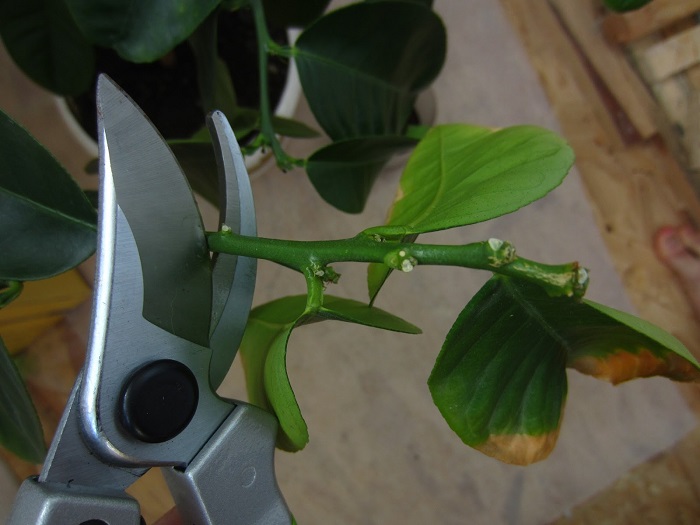
The formation of the crown is also carried out at the moments of picking fruits. Ripe lemon is cut not only with a stalk, but also with a section of the branch itself with 1-2 internodes. This stimulates the growth of the branch.
Lemon is very whimsical to environment and reacts instantly to the slightest fluctuations in temperature or humidity. Steps should be taken to save the plant.
Dried citrus needs watering. By appearance foliage - it becomes yellowish-brownish and rare - it is easy to guess the cause of the disease. But do not rush to irrigate the soil abundantly, you can spoil the root system. It is better to pour a little settled water under the root, and spray around the crown. You can wrap the barrel with gauze folded in several layers and soaked in water. Let the tree stand in this "outfit" for several hours, but do not leave it overnight.
Excess watering will quickly make itself felt with a sudden leaf fall. Seemingly healthy leaves suddenly fly around en masse. As soon as a symptom is identified, proceed with a transplant immediately. Carefully remove the tree from the pot, set it together with the earth lump on newspaper or cardboard so that the roots dry out. You need to plant in the soil, slightly moistened and continue to water moderately.
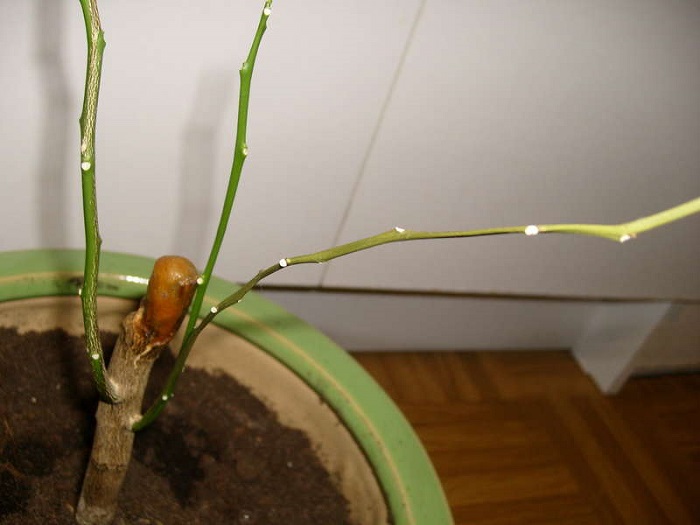
In the photo, homemade lemon with fallen leaves
It is very difficult to save a frozen lemon. In conditions of a sharp cold snap, the vital activity of the plant may cease. In addition to falling foliage, the trunk darkens when freezing. You can try to carry out "resuscitation". To do this, move the lemon to a warmer room, extend the daylight hours with the help of artificial lights. It makes sense to transplant into another pot. When removing, be sure to inspect the rhizome, remove dead and rotten parts. Remove dried branches.
Overheating is no less dangerous for citrus. The emerging brown spots on the leaves clearly indicate overheating. Therefore, on hot summer days, remove the container with the plant deep into the room. Make sure that the air from the air conditioner does not enter the crown. No additional watering or cooling is required.
Important! You cannot often change the place and habitat, it takes a long time and does not adapt well to new circumstances. Therefore, it slows down growth and fruiting, and may even show signs of disease. Drafts and unventilated rooms are equally destructive for him.

Photo of a lemon tree
Lemon pests and diseases
Appearing white flies may indicate stagnation. Their larvae feed on roots and cause significant damage to the plant. To combat them, insecticides of various types are used - irrigation solutions and aerosol forms for the destruction of insects that have managed to hatch. Karbofos and Aktelik are quite effective against these insects.
It is necessary to regularly look at lemon leaves, on which ticks and scale insects can settle. Outwardly, mites are like tiny spiders. They are given out by the color orange or brown, which stands out noticeably against the green background of the back of the leaves. They tighten the damaged areas with a thin cobweb, by which it is easy to recognize pests. Rinse the twigs and leaves on both sides at intervals of three to four days several times under a high pressure shower head. Multiple infusions are effective

- garlic (infuse 1 medium-sized head in 0.5 l of water),
- onions (1 onion, finely grated, poured with a liter of water),
- bay leaf (2-3 leaves per 0.5- liter jar water)
- strong brewing of green tea (for 2 cups of boiled water, 2 tablespoons of dry tea leaves).
Attention! It is not recommended to water the soil with these means.
Scabbards look like small brown turtles, motionless and tightly attached to leaves. It is difficult to deal with them. Three times at weekly intervals, wipe the plant, including leaves on both sides, twigs and trunk, thoroughly with a mixture of soap and kerosene, taken in a ratio of 1 / 0.5. Cover the ground with cardboard or polyethylene, wrap the trunk at the very bottom with a narrow bandage to prevent the penetration of liquid into the root system.
Lemons often get sick from improper care. Brownish leaves on an outwardly healthy plant, and even during the flowering period, is one of the ailments. In this case, reconsider the conditions for keeping the flower, it may make sense to transplant it. But in this case, choose a soil different from that at present. Perhaps it was the acidity of the soil that caused the disease.
Pest videos indoor lemon
As for the human body, disease prevention is important for citrus fruits. To prevent diseases, observe the regime, carry out transplantation, pruning of damaged areas. Sometimes a sudden illness can be dictated by the depletion of the plant itself. In this case, limit flowering to a few buds, and remove the rest, no matter how sorry. Each house has its own separate microclimate, which is not always suitable for lemon. The task of the plant owner is to adapt it to existing conditions gradually.
Sometimes the process of caring for a lemon at home is comparable in terms of the hassle of caring for small children - at the beginning it is difficult, but all the work is rewarded when the tree begins to actively grow.
Lemon is delicious, aromatic and healthy fruit... It can be added to tea, salads, sauces, zest used for baking. You can not even mention the miraculous power of lemon: everyone knows that this fruit is a real treasury of vitamins, and the tree itself purifies the air with the help of phytoncides from harmful bacteria. If so, why not learn more about how to grow lemon at home and not buy more fruit on the market?
It turns out that the domestic lemon culture has become widespread not only in Russia, but in the whole world. We will gladly tell you about how to grow a lemon at home and what the plant and its fruits are.
Lemon - perennial bonsai
Lemons are small trees that can grow for over 45 years. They bloom surprisingly beautifully, bear fruit with natural fruits. Of course, home-grown lemons will be slightly smaller than supermarket lemons. But in terms of the content of nutrients and vitamins, homemade lemons are in no way inferior to store ones, and in some ways even superior.
On one lemon tree, up to 20 small fruits can grow, but only on condition of regular proper care of the plant. Lemon fruit should be cut from the tree as soon as it ripens using a knife or pruner. Too long ripening of lemons will lead to a deterioration in the growth of young growth, as well as to a deterioration in the quality of the fruit.
How to grow a lemon from a seed
In fact, it is not necessary to browse an unlimited number of documents on the Internet on the topic of how to grow a lemon at home from a seed. The photo will really be of invaluable help. But everything can work out without additional materials if you follow the recommendations below for those who really set out to grow a lemon tree at home.
The pits for the tree will need to be taken from ripe lemon purchased from the market. To do this, the lemon will need to be carefully cut in half. Place the bones in a pot of earth no deeper than 2-3 centimeters. When the job is done, they will need to be watered abundantly, while it is important to close the pot of earth itself with polyethylene, periodically letting in air there. After about a month, the first green shoots will appear. They will need to be divided and planted in different pots.
How to grow a lemon at home from a cuttings?
Lemon can be grown from a cuttings at home only if you have patience and make some effort. Growing the plant itself is not the most difficult thing. The main thing is to make it bear fruit, and this can cause problems. From the pits of an ordinary lemon, with which we drink tea, it will turn out to grow the most ordinary tree of traditional sizes. Naturally, you won't be able to keep such a tree at home. And in the garden, the tree will bear fruit only after grafting, and this is one of the most difficult stages in care.
For grafting, you will need to take a bud or stalk from an already fruiting lemon tree. On the trunk of the "new" tree, you will need to make a T-shaped incision, and then insert a bud or stalk there. The incision is made on the trunk, the diameter of which has already reached the diameter of the pencil at the level of 10 centimeters from the pot.
Choosing a place where the lemon tree will grow
Before delving into the intricacies of planting a lemon tree and caring for a plant, you should decide on the place in the room where it will grow.
If the lemon will stand on the windowsill, then you should provide for the location of the plant at a safe distance from the battery. You can choose any window in the apartment, including the one facing the north side. It should only be borne in mind that in winter, in order to avoid hypothermia of the plant's root system, it would be better to rearrange it from the northern window to a warmer place. If you have nowhere to remove the lemon, then in winter you can wrap the skating rink with a cloth with thermal insulating properties, and put foam plastic under the bottom.
Lemon does not tolerate drafts, this fact should also be taken into account when choosing a place for a tree. It is best to place the plant in a light, dry and moderately warm room. The percentage of humidity should not be less than 40 percent, so in winter you can put a container with water near the tree.
How to choose and prepare the soil for lemon
To obtain a soil suitable for planting a plant, it will be necessary to mix garden soil with ash, humus, sand, preferably river sand. The proportion looks like this:
- 1 glass of sand;
- 2 glasses of earth;
- 1 tbsp. a spoonful of ash;
- 3 tbsp. spoons of humus.
All this will need to be mixed until a single mass is formed, which is diluted with water. The mixture should be added to the container where the lemon will grow. It is important that no air voids remain near the root system.
After the plant grown in the container grows up a little (after about 6 months) it will need to be transplanted into the same soil composition, but into a container with a large diameter. Buying ready-made soil in specialized stores, based on peat, is not recommended due to an alkaline reaction, since it is better to grow lemon at home in soil with a neutral reaction.
How to properly fertilize the soil with lemon
In order for a dwarf tree to grow well and bear fruit, it will need to be abundantly fed with fertilizers. You can use the same list of dressings that are recommended for indoor plants, the same "Rainbow", for example, which is available in any of the hardware stores.
To grow a lemon tree at home as quickly as possible, you should fertilize it, but in moderation. An excess of fertilizer can lead to the death of the plant. Most of all, the tree needs fertilization in the spring, during the period when it grows and gains strength, as well as during the ripening period.
In winter, tree feeding is minimized. It is better to add fertilizers to the water for irrigation, as well as use nitrogen-containing fertilizers, sawdust, ash, which will help the tree gain strength and grow stronger. It is imperative to use zinc and copper as fertilizer for the lemon tree.
Features of watering a lemon tree
Watering a lemon tree grown at home should be water settled for 24 hours in an open container with precipitated chlorine. If possible, it is better to use water from a well or well, pre-heated to room temperature. It is not recommended to use rainwater for irrigation, as it contains a large number of harmful impurities.
You can water the lemon every time the top layer of the soil dries out so much that it will crumble when checked in your hands. You need to water so that the roots remain in the ground and are not exposed. It is best to do this gently along the edge of the pot until water appears in the pan.
We take care of lemon correctly
Lemon branches of the fourth-fifth order begin to bear fruit. To do this, you need to prune the tree regularly. Every time the plant reaches 20 centimeters, it will be necessary to cut off the top of the head without touching its buds, it is from them that the first-order shoots will go. This procedure will need to be repeated with subsequent shoots until the fourth and fifth order shoots appear. They are the ones who will bear fruit.
Growing a fruiting lemon tree at home is not easy, so often experts, in order to simplify the task a little, recommend purchasing a ready-made lemon tree, completely ready to bear fruit. Everyone has the right to choose for himself - to grow a tree from a stone or buy a ready-made one, caring for it while waiting for the fruit.
To give up the process of growing and caring for a lemon tree means depriving yourself of the pleasure of enjoying your own-grown aromatic and healthy lemons. And difficulties are fixable, especially when there is somewhere to look for advice on how to grow lemon at home with video, photos and detailed instructions and the recommendations of experts in this matter.


